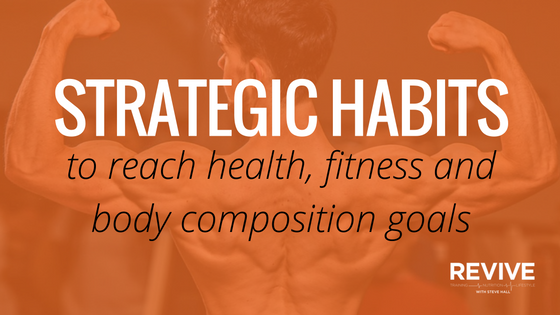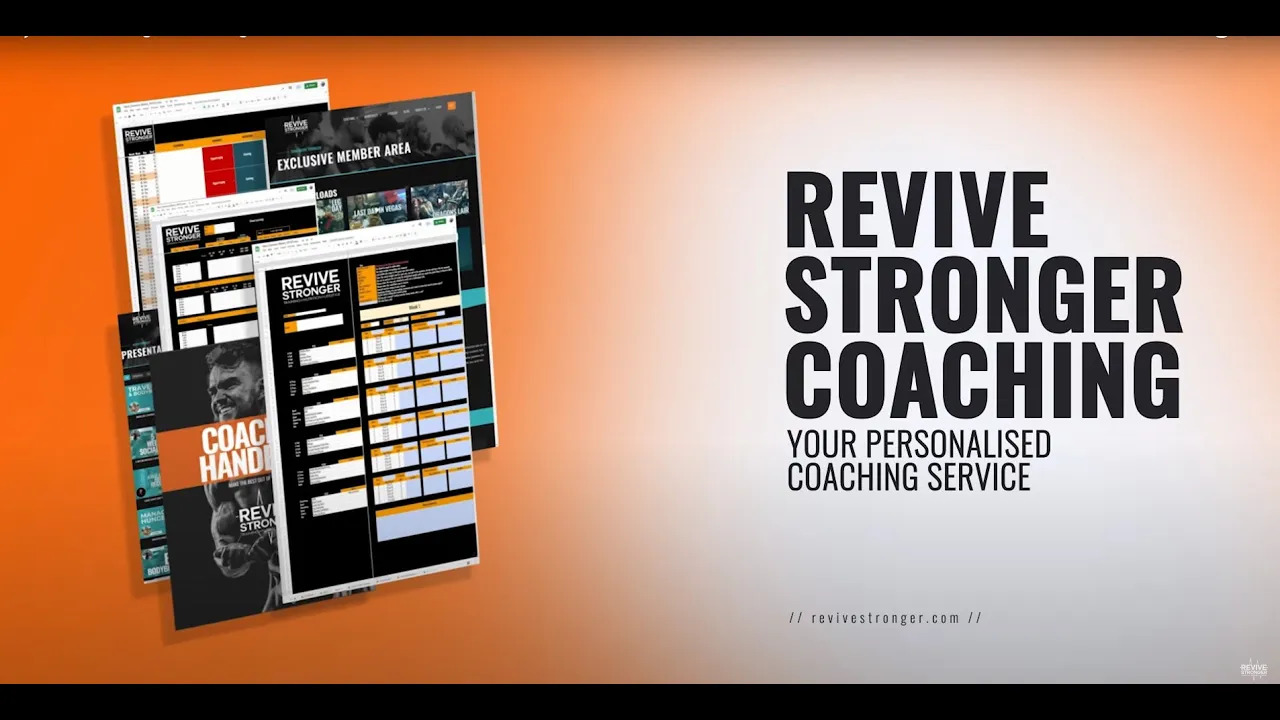
Revive Stronger
Strategic Habits: to reach health, fitness and body composition goals

Habits can make or break you.
My friend and client Emma Green knows this, and has done a lot of research into the subject. She is going to take you through:
- What habits are
- How long they take to form
- How to develop them & keep them
- How to drop bad habits
Take it away Emma…
Every day we are faced with a huge number environmental triggers and many choices to make about our behaviour. It may seem as if we make careful and considered decisions based on rational and thoughtful processing of information, yet most of the time, our behaviour reflects little or no reflection.
[bctt tweet=”most of the time, our behaviour reflects little or no reflection” username=”revivestronger”]
Sometimes, our behaviour is an automatic response to a cue in the environment. Cued responses might be impulsive reactions to particular features of a food, such as the smell of fresh pizza. How we act may also be triggered by a particular situation, such as cake at a work colleague’s birthday. Surprisingly, our intentions to perform in a particular way aren’t very good predictors of them actually carrying them out [1].
Habits, therefore, play a fundamental role in generating our behaviour and can be used strategically to help us reach our health, fitness and body composition goals.
[bctt tweet=”Habits can be used strategically to help us reach our health, fitness and body composition goals” username=”revivestronger”]
Table of Contents
What is a habit?
As a ‘habit’ is both an abstract and socially defined concept, there is no objectively ‘correct’ way of defining it [1].
Some definitions describe habit as being a particular behaviour which is generated from specific processes, others define habits as the tendency to engage in a certain behaviour and others as the automatic nature of a behaviour [1]. The latter of these definitions is arguably the most useful because it allows for the exploration of the underlying cognitive processes of the behaviour. This definition will be used in the remainder of this article.
[bctt tweet=”a habit is the automatic” username=”revivestronger”]
What types of behaviour are habitual?
Habit has been applied to a variety of health behaviours, including diet, physical activity and alcohol intake [1].
It’s important to note that behaviours such as physical activity consist of a series of steps (e.g. getting changed into gym clothes, packing your bag for the gym, driving/ walking to the gym and engaging in exercises when at the gym).
If these behaviours are habitual, this does not necessarily mean that all aspects of the behaviour are completed unconsciously. For example, driving/ walking to the gym may be habitual but performing the exercises at the gym likely involves conscious thought (thinking about form, number of repetitions/ sets etc). The reverse can also be true (ever seen anyone mindlessly pounding away on the treadmill?).

How long do habits take to form?
You’ve likely heard the phrase ‘It takes 21 days to change a habit’. The magic number 21 appears in many articles about forming a new habit but little is known about the origins of this claim.
So where does the magic ’21 days’ figure come from?
In the preface to his 1960 book ‘Psycho-cybernetics’, Dr Maxwell Maltz, a plastic surgeon turned psychologist wrote:
‘It usually requires a minimum of about 21 days to effect any perceptible change in a mental image. Following plastic surgery it takes about 21 days for the average patient to get used to his new face. When an arm or leg is amputated the “phantom limb” persists for about 21 days. People must live in a new house for about three weeks before it begins to “seem like home”. These, and many other commonly observed phenomena tend to show that it requires a minimum of about 21 days for an old mental image to dissolve and a new one to jell.’ (pp xiii-xiv)
It’s unclear how anecdotal evidence from plastic surgery patients came to be generalised so broadly. Although ‘21 days’ may apply to adjustment to plastic surgery, it’s not generalizable to all habitual behaviours.
So, if not 21 days, then, how long does it really take to form a habit?
Researchers from University College London (UCL) conducted a rigorous study of habit formation [2]. Participants performed a self-selected health-promoting dietary or activity behaviour (e.g. drinking a glass of water) in response to a once-daily cue (e.g. after breakfast), provided daily self-reports of how automatic (i.e. habitual) the behaviour felt and were tracked for 84 days.
Automaticity typically developed in a distinct pattern:
- Initial repetitions of the behaviour led to quite large increases in automaticity
- But these increases reduced in size the more frequently the behaviour was repeated
- Until automaticity plateaued
Researchers assumed that the point where automaticity was rated highest was also the point when the habit has formed and so concluded that it took 66 days on average for the habit to form.
[bctt tweet=”it takes 66 days on average for the habit to form” username=”revivestronger”]
Interestingly, there were quite large differences between individuals in how quickly behaviours became automatic. For one person it took just 18 days, and another did not get there in the 84 days, but was predicted to take 254 days. There was also variation in how strong the habit became.
It’s possible that some behaviours are more suited to habit formation than others. Habit strength for simple behaviours peaked quicker than for more complex behaviours. It’s also possible that individuals differ in how quickly they can form habits, and how strong those habits can become. This means it likely takes much longer than 21 days to make a behaviour habitual but with each repetition of the behaviour, it will get more and more automatic.
How do we form habits?
In addition to knowing how long it takes for a behaviour to become habitual it’s important to know how we can encourage behaviour to become habitual.
The first step in forming a habit involves translating our intentions into behaviour. Our intentions to do something are poor predictors of whether we actually do it (how many people say they will start their diet on Monday?). Studies have found that amongst those intending to perform in a certain way, less than 50% of individuals actually did what they said they’d do [3]. This is known as the ‘intention-behaviour’ gap; you intend to do it, but you don’t.
[bctt tweet=”I’ll start my diet on Monday…the intention behaviour gap epitomised” username=”revivestronger”]
Implementation intentions are a type of ‘action plan’ which detail the specifics of when and where the behaviour will be performed [3]. For example, instead of stating ‘My goal is to go to the gym 3 days per week’, which is non-specific, it’s better to state ‘I will go to the gym on Monday, Wednesday and Friday at 5pm when I have finished work’. The latter is better because it specifies the time when the behaviour will be performed (5pm) and describes the cue that will be used (finishing work).
Make a plan B
Implementation intentions also involve making ‘If-then’ (back up) plans. For example, ‘If I have a work event on Monday evening then I will go to the gym at 6am on Tuesday’. Making such plans is important because it ensures that obstacles which may be encountered are anticipated and successfully overcome.
They’ve also been shown to be effective in increasing the likelihood of a behaviour being performed and the level of habituation of the behaviour over time [3]. They’re thought to operate by increasing the awareness of the particular situational cue in memory and thus creating a stronger association to a certain behaviour. It is important to note that one ‘lapse’ (e.g. a missed workout) has a minimal impact on habit formation as long as the behaviour is resumed shortly afterwards. A good example of this is flexible dieting.
Keep consistent with your habits
Once we have begun to initiate a behaviour regularly, it’s also important to remain consistent with the behaviour in order to achieve our goal [3]. Studies have shown repeating a behaviour usually depends on how enjoyable the behaviour is for the individual [3]. This isn’t a surprising finding but it highlights the importance of finding something enjoyable about the process of achieving a goal.
[bctt tweet=”enjoy the process as much as the outcome” username=”revivestronger”]
How do we maintain habits?
Satisfaction is important in maintaining behaviour needed to achieve a goal [3]. This is thought to be significant because it provides confirmation for the individual that their decision to begin the behaviour was correct.
Satisfaction occurs from obtaining the desired outcomes of a behaviour. For example, becoming leaner after beginning a workout programme at the gym and starting to track your calorie and macronutrient intake. This can be problematic when people have unrealistic ideas about the consequences of behaviour change (e.g. going to the gym for a month and expecting to have a six-pack). Managing expectations at the start and during the process of behaviour change is therefore very important to ensure consistency.
[bctt tweet=”set realistic goals” username=”revivestronger”]
Research suggests that people should focus on different outcomes of their behaviour depending on their goals [3]. This can include directing attention to outcomes which may not have been anticipated. For example, when making changes to diet, focusing on having more energy and better digestion is better than only focusing solely on fat loss.
Monitor progression
Self-monitoring using a range of variables can also help to sustain behaviour change. For example, tracking gym performance, energy levels, sleep patterns, measurements as well as scale weight. Studies have shown self-monitoring can be effective in encouraging people to stick with their behaviour, particularly when positive feedback is given (e.g. from a coach) [3].
Self-monitoring can also enable for goals to be changed when needed, depending on the results achieved (or lack of). For example, if going through a period of high stress and fat loss has plateaued for several weeks, it might be a good time to take a diet break and eat at maintenance for a while. Whilst eating at maintenance, gym performance should increase, as well as energy levels and sleep. Self-monitoring helps to make sure these changes are tracked.
Reward yourself (with caution)
Although context-dependent repetition of a behaviour is necessary in order for a behaviour to become habitual, it is unlikely to be sufficient [3]. Rewards can be important in reinforcing the behaviour.
There are different types of rewards:
- Extrinsic (tangible rewards: eg a yummy post-workout treat)
- Intrinsic (eg feeling a sense of satisfaction after pushing through a tough workout)
Extrinsic rewards can also be described as being anticipated beforehand and if so, dependent on either performing the behaviour (eg going to the gym) or on achieving a certain outcome (eg losing 5 pounds).
Providing extrinsic rewards for each repetition of the behaviour can be detrimental to the habit formation process [3]. This is because it can lead to future performance being driven by the expectation that a reward will be received which reduces the intrinsic motivation to perform the behaviour. By definition, if we do something only to obtain a reward then it’s not habitual. This is because the behaviour is likely to be ceased when the reward is removed [3]. Extrinsic rewards are therefore only useful when they do not become the goal of performing the behaviour.
This means it’s best to use rewards with caution!

As mentioned earlier, cues are important in triggering behaviour. In theory, any significant features of the environment can become cues but some cues seem to be better than others in encouraging habit formation [3]. Behaviours tend to be ‘chunked’ together with one behaviour flowing onto the next (e.g. brushing then flossing your teeth). Therefore when selecting a cue for a new behaviour, it is best to use a behaviour which falls at the end of a task sequence (e.g. leaving the office).
[bctt tweet=”chunk your habits together e.g. put your plate on a scale before eating” username=”revivestronger”]
What about breaking habits?
Creating new healthy habits often requires replacing an existing behaviour for a more desirable alternative [3].
As mentioned earlier, intentions are not a good way of predicting the likelihood of actually doing something. This means that despite ‘good intentions’ in certain situations, people are likely to revert to their old habits, despite being motivated to do otherwise. For example, merely setting the intention to make a lower calorie choice at a restaurant is unlikely to be a successful strategy if every time you have been to the restaurant in the past you have ordered a burger, fries and a dessert.
[bctt tweet=”intending to do things & actually doing things are very different” username=”revivestronger”]
A possible solution to breaking a habit is removing the individual from the situation which triggers that behaviour [3]. This may be feasible in certain situations (e.g. walking a different route to work so that you don’t pass a sweet shop) but not necessarily all of the time. It’s also beneficial to make the most of the situations where the environment is naturally changing (e.g. moving house, starting a new job etc).
Set reminders
Reminders can also be helpful when trying to break a habit because they interrupt the behaviour [3]. It’s important that such reminders do not only contain an instruction not to perform a certain behaviour (e.g. don’t eat the biscuit) but instead advise an alternative behaviour (e.g. eat an apple instead of a biscuit). If we do this consistently, it will become habitual and the old habit will have ceased. Setting reminders is particularly easy with the assistance of technology (smart phones, computers etc).
Look at your daily actions & think
Self-reflection is also helpful when trying to break habits [3]. It’s important to identify the situations and conditions which trigger the behaviour and either avoid these situations (if possible) or make a plan B.
Conclusion
There are several important things to remember about habits:
-
Habits take on average 66 days to form (sorry!)
-
Making a specific plan helps in establishing new habits and breaking old ones
-
Continued repetition of a behaviour is needed for it to become habitual (this can be aided by rewards and self-monitoring )
-
Selecting a suitable cue is important when trying to establish new habits
-
It is possible to capitalise on naturally occurring changes to form new habits/ break old habits
-
Reminders are useful when trying to break old habits
-
Self-reflection can help to identify the contexts when particular behaviours occur
What Next?
I’ve got a task for you…
- Think about what habits you’d like to ingrain, write down 5.
- Make a specific plan for the highest priority habit.
- Stick to this for the next 3 months, monitor your progress and reward yourself each week you stick to it.
If you want to contact Emma you can email her on: [email protected]
One more thing…
Do you have a friend who would love the above? Share this article with them and let me know what they think.
[bctt tweet=”Strategic Habits: to reach health, fitness and body composition goals” username=”revivestronger”]
References
- Gardner, B. (2015). A review and analysis of the use of ‘habit’ in understanding, predicting and influencing health-related behaviour. Health Psychology Review, 9(3), 277-295.
- Lally, P., Van Jaarsveld, C. H., Potts, H. W., & Wardle, J. (2010). How are habits formed: Modelling habit formation in the real world. European journal of social psychology, 40(6), 998-1009.
- Lally, P., & Gardner, B. (2013). Promoting habit formation. Health Psychology Review, 7(sup1), S137-S158.
We are a personal coaching service that helps you achieve your goals. We want you to become the best version of yourself.









Comments are closed.